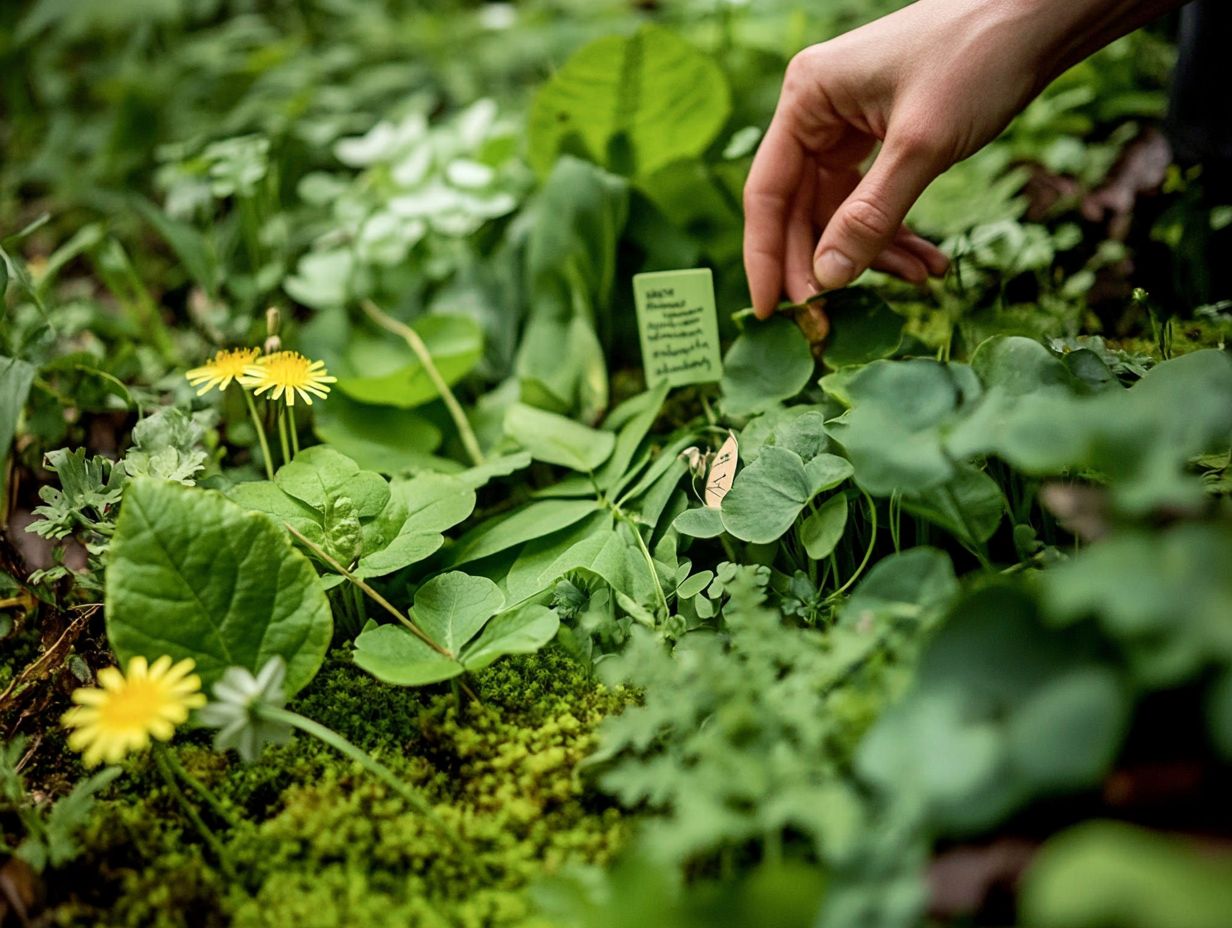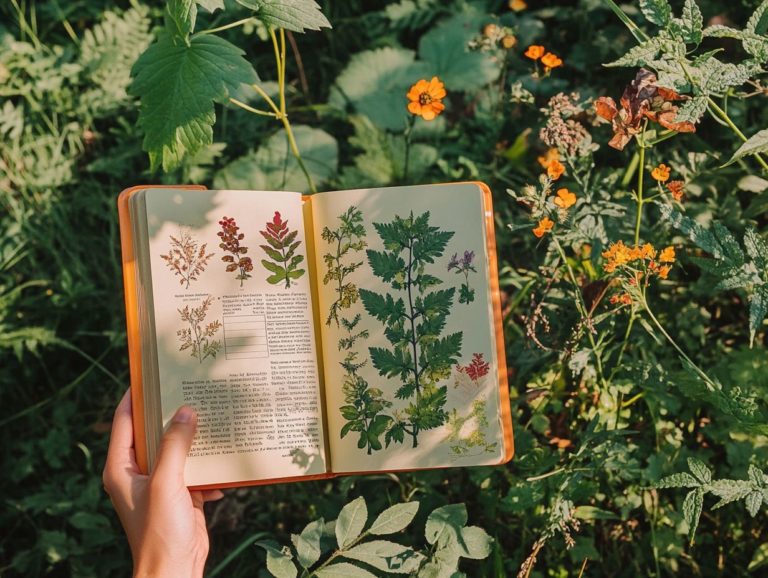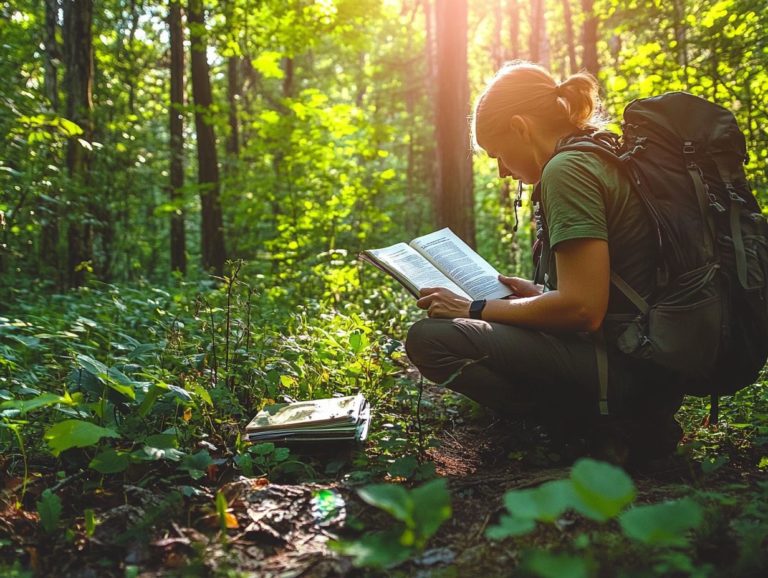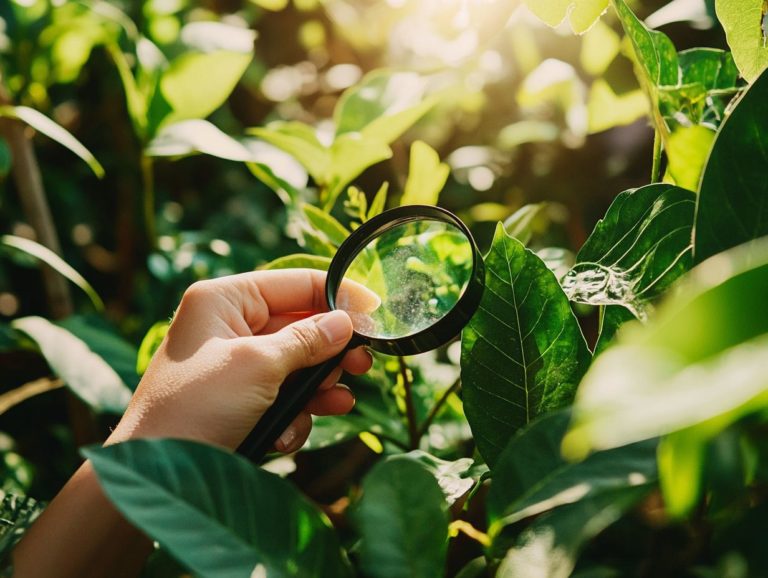How to Identify Safe Wild Edibles
Wild edibles provide a unique connection to nature while offering a sustainable way to enhance your diet.
Before you set off on your foraging adventure, it’s crucial to familiarize yourself with the safe identification of these edible plants and their characteristics.
This article equips you with tips for spotting edible plants, highlights common look-alikes to steer clear of, and underscores the safety precautions needed for safe harvesting and preparation.
You will uncover the health benefits of incorporating wild edibles into your meals, such as pinyon nuts and blueberries, along with inspiring recipe ideas to spark your culinary creativity.
Dive excitedly into the fascinating world of wild foraging, where you can learn about techniques and practices that enhance your foraging experience!
Contents
- Key Takeaways:
- What are Wild Edibles?
- Identifying Safe Wild Edibles
- Precautions When Harvesting and Eating Wild Edibles
- Benefits of Incorporating Wild Edibles into Your Diet
- Frequently Asked Questions
- What are wild edibles and why is it important to identify them safely?
- How can I identify safe wild edibles?
- What are some common mistakes people make when identifying wild edibles?
- Are there signs to identify safe wild edibles?
- What precautions should I take when identifying wild edibles?
- What should I do if I consume a poisonous plant?
Key Takeaways:

- Always consult an expert or reliable source, such as Peterson’s Field Guide or The Forager Handbook, before consuming any wild edible to ensure proper identification.
- Be cautious of common look-alikes that may be toxic or harmful when foraging for wild edibles, as identifying these plants accurately is crucial for your safety.
- Proper cleaning and preparation techniques are essential to minimize potential risks and allergies when consuming wild edibles, especially for foragers new to this practice.
What are Wild Edibles?
Wild edibles are not just plants; they are a gateway to self-sufficiency and a profound connection with nature. These remarkable resources include a diverse array of species, from luscious berries and nutritious nuts to intriguing mushrooms.
By exploring these offerings, you gain not only essential nutrients but also a chance to engage with the environment in a truly meaningful way. As you venture into the wild, you ll discover a treasure trove of flavors and ingredients that support a sustainable lifestyle and elevate your culinary adventures.
Identifying Safe Wild Edibles
Identifying safe wild edibles is essential for anyone venturing into foraging, as the natural world is woven with both nutritious delights and toxic impostors that can pose significant health risks. A helpful resource for this is Identifying Safe Edibles: A Forager’s Guide.
To forage safely, you need to cultivate key identification skills through careful observation and diligent research. Learning about identifying wild edibles in your local area will help you recognize the distinct characteristics of edible plants such as their growth patterns, colors, and shapes.
Engaging with experts and utilizing resources like Peterson’s Field Guide can significantly elevate your confidence in recognizing and harvesting these natural treasures.
Expert Tips for Identification
Experts in foraging, like John Kallas and Andrew Townesmith, provide invaluable insights that can enhance your ability to identify edible plants along trails. They stress the importance of understanding the unique characteristics and habitats of these plants, dramatically improving your skill in distinguishing between safe and toxic varieties.
By familiarizing yourself with local flora and participating in hands-on workshops, you empower yourself to venture confidently into nature s bounty.
Recognizing distinct features such as leaf shape, flower color, and growth patterns is essential for telling edible species apart from their perilous counterparts. Resources like field guides and online databases are invaluable for this purpose, while local workshops connect you directly with experts who share their firsthand knowledge.
Attending forage walks can also foster connections with fellow enthusiasts, promoting a sense of community and collaborative learning. Engaging in these educational opportunities not only enhances your skills but also deepens your appreciation for the environment, reinforcing the importance of sustainable practices when gathering wild edibles.
Join a local workshop today to start your adventure!
Common Lookalikes to Avoid

When foraging for wild edibles, it is crucial to be aware of common look-alikes that can be toxic and potentially harmful if consumed. Many edible plants have counterparts that closely resemble them, making careful identification of edibles and observation vital for your safety.
For example, the delicate leaves of wild garlic can easily be mistaken for those of the toxic lily of the valley. While wild garlic can enhance the flavor of your dishes, the lily of the valley poses serious cardiac risks.
Similarly, wood sorrel, known for its safe, tangy taste, can be confused with the harmful shamrock. Consuming shamrock can lead to a stomach upset.
Paying attention to details like leaf shape, flower color, and stem structure can help you avoid dangerous mix-ups. Dedicating time to thoroughly research these plants and consulting local foraging groups will significantly enhance your identification skills. This ensures that your foraging journey is both rewarding and secure, aligning with sustainable practices. With the right knowledge, you can forage confidently and safely!
Precautions When Harvesting and Eating Wild Edibles
Taking precautions when foraging and consuming wild edibles is essential for your safety and well-being. Refer to these safety tips to ensure a mindful experience—your safety depends on it!
It is important to be aware of potential allergies and to master proper cleaning techniques. Familiarize yourself with the environmental conditions where these edibles thrive; after all, pollution and habitat degradation can significantly affect their safety.
By adhering to proper cleaning and preparation methods, you can minimize risks. This transforms the experience of enjoying these nutritious plants into a delightful and secure culinary adventure.
Proper Cleaning and Preparation Techniques
Proper cleaning and preparation techniques are crucial for ensuring that the wild edibles you gather are safe and delightful to consume. Start by rinsing your foraged plants thoroughly to eliminate dirt, insects, and any potential contaminants before diving into preparation.
Soaking leafy greens in a vinegar-water solution for a brief moment is a good idea; this helps dislodge any stubborn pests and bacteria. For tougher parts like roots and stems, use a vegetable brush it s remarkably effective.
Keep in mind that some wild edibles might have bitter or irritating qualities. A quick boil in water for a minute or two can work wonders. This significantly reduces unwanted flavors, making them much more enjoyable, especially in recipes. By mastering specific techniques for different types of edibles, you enhance the safety of your dishes while also elevating their flavors. This allows you to truly savor the unique essence of these natural ingredients.
Possible Risks and Allergies
When you embark on the journey of foraging for wild edibles, it’s vital to recognize the potential risks and allergies that can arise from consuming unfamiliar plants. Certain individuals may have specific allergies to particular edible species, leading to adverse reactions.
This makes it essential to identify and understand the plants you are harvesting by utilizing resources such as the Missouri Botanical Garden or expert books. Being well-informed about common allergens and exercising caution can significantly enhance your foraging experience while prioritizing safety.
Not every plant that looks edible is safe for consumption; some harbor toxic substances that can induce severe illness or even pose life-threatening risks. Therefore, it is crucial to educate yourself on the safe identification of these plants and the potential dangers linked to their consumption.
Understanding which parts of a plant are safe and mastering the proper preparation methods can greatly mitigate risks. By emphasizing education, awareness, and a deep respect for nature, you can cultivate a rewarding and safe foraging experience by following safety guidelines for harvesting wild edibles that resonates with your passion for wild edibles and sustainable practices.
Benefits of Incorporating Wild Edibles into Your Diet

Adding wild edibles to your diet has many benefits. It boosts your nutrition and promotes sustainability in your community.
These plants offer unique flavors and health advantages. They also help you connect with nature and local ecosystems.
By mastering the art of picking wild foods safely, you can support sustainable agricultural practices. Enjoy the diverse array of edible plants that your environment generously provides.
Nutritional Value and Sustainability
Wild edibles are a treasure trove of unique flavors and impressive nutritional benefits. They make a superb addition to any health-conscious and sustainability-focused diet.
Many of these plants are rich in vitamins, minerals, and antioxidants. Embracing wild edibles allows you to make sustainable food choices that enhance your well-being and support the planet.
These natural foods often grow abundantly, requiring little to no cultivation effort. This encourages a lifestyle that honors and harmonizes with nature.
Take dandelion greens, for example; they re often overlooked yet packed with vitamins A, C, and K. Then there are nettles, which provide a wealth of minerals that boost immunity and overall vitality.
Foraging isn t just about gathering food. It deepens your connection to the environment and fosters a sense of community through shared knowledge.
Recipes and Ideas for Using Wild Edibles
Exploring recipes and ideas for using wild edibles can elevate your culinary experience. Infuse your dishes with unique flavors and ingredients sourced straight from nature.
Imagine crafting salads with foraged greens or baking desserts featuring luscious wild berries. Endless creative possibilities await!
Engaging with your community to exchange recipes deepens your appreciation for the local environment and nurtures sustainable practices.
Whether you re gathering dandelion leaves for a refreshing pesto or incorporating fragrant wild garlic into a savory dish, these natural ingredients can transform your everyday meals into extraordinary feasts.
You can experiment with textures and tastes, perhaps using acorns to create hearty flour for breads or infusing elderflowers into syrups for delightful beverages.
Dive into this adventure and discover new flavors! Don t hesitate to inspire others by sharing your culinary triumphs and tales from your foraging adventures.
Frequently Asked Questions
What are wild edibles and why is it important to identify them safely?

Wild edibles are plants found in nature that are safe for human consumption. It is crucial to identify edible roots in the wild safely because some plants may look similar to edible ones but can be poisonous.
How can I identify safe wild edibles?
The best way to identify safe wild edibles is through thorough research on the plants in your foraging area. Resources such as how to spot edible plants in the wild can be invaluable, along with consulting reputable field guides or an expert.
What are some common mistakes people make when identifying wild edibles?
One common mistake is assuming that a plant is safe to eat just because it looks similar to a known edible plant. It is essential to positively identify a plant before consuming it.
Another mistake is not checking for poisonous look-alikes, as some plants may have similar characteristics but can be dangerous if ingested.
Are there signs to identify safe wild edibles?
Yes! Look for plants that people have safely eaten for a long time.
They should be plentiful in your area and have clear features that make them easy to recognize.
What precautions should I take when identifying wild edibles?
Ensure you can confidently identify a plant before eating it.
Start with a tiny amount and wait a few hours to check for any reactions. Always wash the plant before consuming.
What should I do if I consume a poisonous plant?
Seek medical help right away if you think you ve eaten a poisonous plant.
Bring a sample with you to the hospital for accurate identification. Remember, prevention is key always double-check your wild edibles!






